Schools today need to have an active online presence to attract prospects. By establishing this presence across various channels, your school can increase its chances of reaching its prospects. Having a strong multi-channel marketing strategy in this current competitive digital landscape is instrumental, and it can easily set your school apart from its competition.
As you explore inbound marketing strategies, advertising and lead generation, consider consolidating your efforts through a multi-channel marketing approach. Read on for the inside scoop on how your school can effectively embrace multi-channel marketing.
A Breakdown of Multi-Channel Marketing for Schools
As you start to develop your digital marketing strategy, you’ll need to know exactly what to expect with multi-channel marketing. A good starting point is answering the question, “What is multi-channel marketing?” Basically, it’s a marketing approach that uses different distribution and promotion platforms to reach target audiences.
Multi-channel marketing can involve anything from your school’s website and emails to your social media accounts and ads. Each channel functions individually to promote your school’s messaging. The idea is that by having a presence on multiple platforms and using different channels, you can provide prospects with multiple ways of engaging with your school.
There are numerous benefits to consider for using a multi-channel marketing strategy. You can expect:
- A boost in brand awareness—more channels create more opportunities to be visible to your audience
- Increased conversion rates—more channels provide prospects with more ways to engage with calls to action and convert
- More effective targeting—different channels allow you to attract different audiences and student personas
- Better experiences for prospects—more channels create higher chances of prospects finding what they’re looking for, leading to a more positive marketing experience
With this in mind, you can feel more confident building your school’s multi-channel marketing plan template. Here are the best practices to follow for a higher chance of success!
1. Understand Your School’s Prospective Students
Knowing your audience is the first key step in a multi-channel marketing strategy. In fact, it’s crucial to any marketing activity—making it a priority for your school. To kick-start your efforts, begin with a deep dive into your target audience.
This is a good time to ask yourself the following questions:
- What kind of student are you trying to attract?
- What are some of their concerns and motivations?
- What type of messaging will resonate with them?
- Where are they likely to spend most of their time online?
As you explore the answers to these questions, you can create a student persona, a semi-fictional representation of your school’s prospects. This persona will highlight key motivations and concerns along with the demographic information of your target audience. With all this data gathered in one place, you can develop key messages that make an impact—which you can then use across different channels.
The image below shows what a student persona document can look like. This particular document features a persona name, making it easier for school teams to communicate internally. Information is divided into clear categories that allow teams to quickly scan the text and glean valuable insights:

Your student personas will give you an idea of which channels you need to focus your marketing efforts on while also informing your tone and messaging. That’s because you’ll know what would attract your student personas. To standardize your marketing efforts, it’s a good idea to include this information in your student persona document. This makes it accessible to everyone on your school’s marketing team, ensuring that each member—no matter what tasks or channels they’re working on—understands who you’re trying to target:
This image is an excerpt of the key messages developed for the student persona shown above. These messages reflect how the school aims to address the persona’s motivations and concerns, highlighting key factors and unique selling points that align with your school’s persona research:
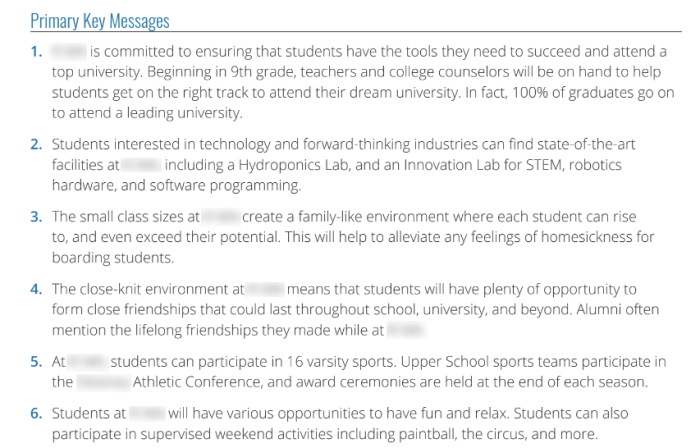
By going through these steps in your multi-channel campaign, you’ll ensure that your team thoroughly understands your audience and can craft content that will effectively attract them no matter what platform or channel your school uses.
Pro Tip: Using relevant, high-quality content that factors user intent and prioritizes your personas’ interests can lead to impressive results. This way, your messaging and content will put the needs of your audience first, which can ultimately generate a high return on investment.
2. Create Multiple Touch Points to Interact with Your School’s Prospects
A successful multi-channel marketing strategy includes multiple touch points on different platforms. This includes your school’s website, social media, email newsletters, and anything else that prospects use to engage with your school.
Naturally, dedicating the time and effort for each channel can be difficult and costly for many schools, especially those with small teams. For this reason, you’ll want to focus your efforts on a few channels that you know will yield great results.
In addition to your student personas, you’ll need to rely on SMART goals—Specific, Measurable, Attainable, Relevant, and Time-bound objectives that guide your marketing efforts. Based on your school’s goals and what you want to accomplish, you can build a multi-channel marketing campaign that makes the most sense for your school. That means choosing the channels that your audience gravitates to and managing potential ads and content production efforts as per your budget and resources.
It’s generally best practice to start small and build momentum as you grow. Once you begin to see results and grow your resources, your school’s team can consider branching out to other channels as part of your digital marketing strategy.
The Academy of Learning College (AOLCC) has developed a solid online presence on various platforms, providing great multi-channel marketing examples. Its reach includes its website blog, LinkedIn, and Instagram (all shown below), as well as Facebook, Twitter, and YouTube.

Source: AOLCC – Blog
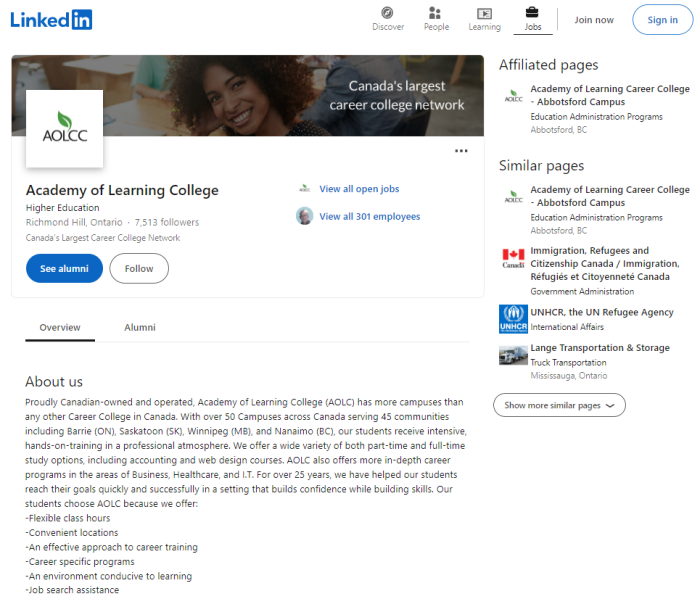
Source: AOLCC – LinkedIn
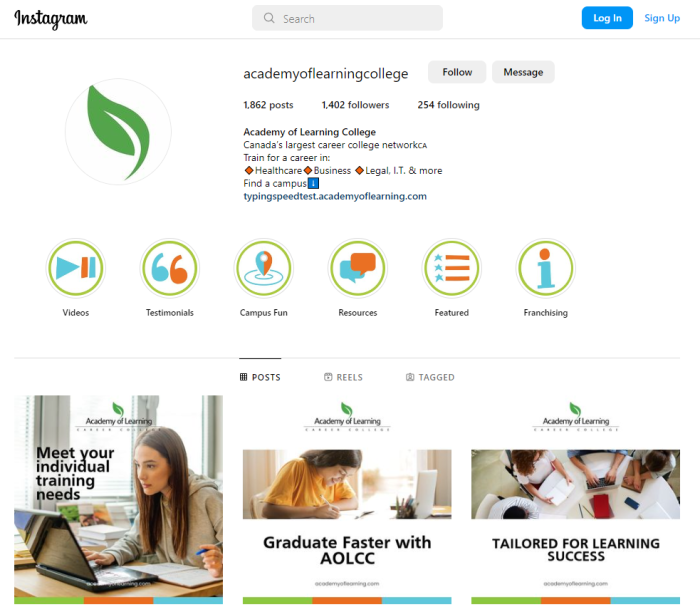
Source: AOLCC – Instagram
Understanding how each channel works can ensure your success on that platform. This is a good time for your team to review each platform’s algorithms and hashtags as well as best practices. You can also update your multi-channel marketing strategy to factor in the latest industry trends and shifting audience behaviors.
3. Embrace Cross-Channel Marketing in Your Multi-Channel Marketing Strategy
To increase your chances for success, it’s important to make each channel work well with any other channel you use in your multi-channel marking strategy. Applying a cross-channel marketing approach can help you accomplish this goal.
Cross-channel marketing is a subcategory of multi-channel marketing, and it’s similar to it in that both require the use of multiple platforms. The difference is that cross-channel marketing is about creating a seamless marketing experience, one where information from one channel flows freely to the next. This way, prospects are presented with consistent messaging across various channels—preventing them from encountering anything jarring or confusing as they engage with your school’s brand.
In a cross-channel marketing model, prospects can cross over from one channel to another before they convert and apply at your school. Here, each channel would complement the other. Multi-channel marketing campaigns that use a cross-channel approach can produce the following benefits:
- More personalization for prospects—which, in the case of personalized calls-to-action (CTAs), can result in a 202% better performance.
- Increased brand loyalty—cohesive marketing initiatives that prioritize prospects across all channels can promote a positive sense of community, nurturing deeper connections with prospects
- Higher conversion rates at a lower expense—cross-channel marketing data allows your school to identify how prospects move throughout the enrollment journey and where they convert, allowing you to tailor your messaging and content for better results.
There are different ways to bring a cross-channel marketing campaign to life for your school. One example could be emailing prospects who have started an application but did not yet submit. The email could remind prospects of their deadline, provide additional resources, or even offer a private informational session. This is the approach that the University of Aberdeen takes when a prospect begins an application on its website:

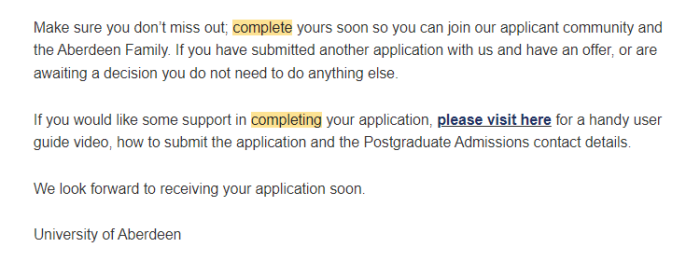
Source: University of Aberdeen
Ready to embrace multi-channel marketing? Get in touch with our team of education marketing experts to develop your school’s digital marketing strategy!
4. Use Your School’s CRM and Marketing Automation to Your Advantage
Your school’s Customer Relationship Management (CRM) software is a powerful tool that can be useful in multi-channel marketing strategies. That’s because it can help you integrate the same marketing experience across different channels, making it easier for you to use cross-channel marketing.
You can use your CRM to track interactions and engagement—anything like visited pages, CTA clicks and opened emails. Your CRM will store this information, and score leads based on their likelihood to convert and apply at your school. You can set up your CRM to prioritize actions that your school values most, allowing you to identify high-quality leads more efficiently. Once you’ve identified your group, you can begin rolling out targeted marketing campaigns using the information you have saved in your CRM.
Automating this process can save your school lots of time and resources. Marketing automation can be configured in your school’s CRM and triggered per your specifications.
Example: Prospects who take the Career Training Readiness Quiz on Oxford College’s Business Management program page on the website receive their results via email (first image). Later on, these prospects receive a follow-up email providing extra information and an offer to schedule a personal meeting (second image):


Source: Oxford College
Using marketing automation in these types of multi-channel marketing strategy examples can make it easier for your admissions team to connect with prospects. It can also help ensure your prospects receive your messaging, giving you more chances to build relationships and interact with them.
5. Leverage Your Marketing Analytics by Tracking Your KPIs
You can use your marketing analytics to define multi-channel marketing for your school. This can be done through Google Analytics 4 as well as your CRM. With Google Analytics, you can monitor your engagement and observe traffic across different channels:
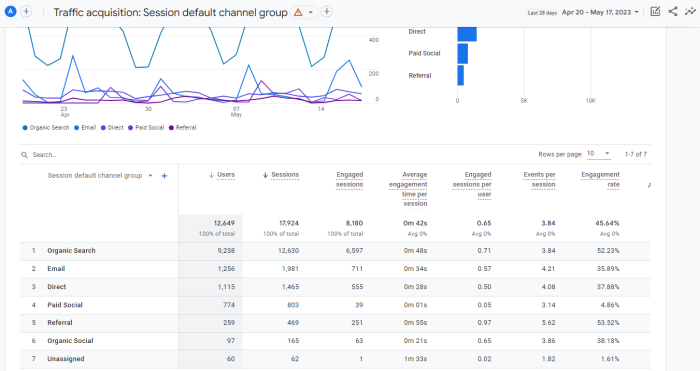
These insights can help you determine which channels are performing well and which need an extra boost. Depending on your goals and resources, you can decide which ones to focus your efforts on. Schools can also use a CRM to track this type of data. In HEM’s Mautic CRM, you can navigate to the “Leads by Channel” Report and view how well different channels converted your school’s leads:
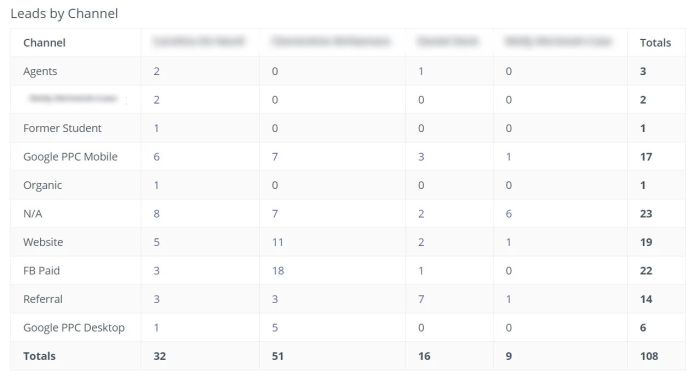
A closer look at conversion tracking and attribution can also be especially helpful. Essentially, you’ll want to ensure that conversions are accurately credited in your analytics. Depending on the attribution model you select, you can assign credit for conversions to different touchpoints, which can be especially handy in multi-channel marketing.
Typically, schools benefit from using a Last-Click attribution model—which focuses on clicks instead of views, making it extremely useful for lead generation tracking. That said, different schools may want to track different things and exploring attribution is one of the first steps.
Pro Tip: It’s a good idea to test your efforts so that you’re able to confirm whether or not they’re generating the desired results. When it comes to your multi-channel marketing strategy, you can divide your audience into a group that receives a multi-channel promotion and one that does not. You can then analyze your data to find out if your efforts are yielding a high return.
6. Consider Retargeting along with Your Multi-Channel Marketing Strategy
Retargeting can help you make the most of your school’s multi-channel marketing plan. It’s a type of advertising that specifically targets prospects who have visited your school’s website or social media account. When used in a multi-channel marketing strategy, it can amplify your results.
That’s because multi-channel marketing naturally increases your website traffic. The more prospects visit your website, the bigger the return on your retargeting efforts become. You’ll end up with a bigger group of prospects who will likely re-encounter your ads, reminding them of your school and prompting them to convert. An effective example can be creating a social media ad on one platform, like Facebook, to target a prospect who then goes on to another social media platform, like Instagram, where they would see that same advert.
Ultimately, your goal with a multi-channel marketing strategy is to provide prospects with different ways to connect with your school. Each platform would prioritize your prospects’ needs so that you can nurture more meaningful relationships in different digital spaces, bolstering your student recruitment efforts.







